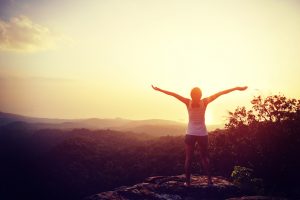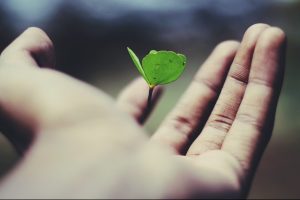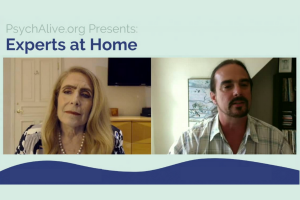The Power of Not Knowing
 On a beautiful afternoon not long ago, cottony clouds breezed across a clear sky. Desert sand soaked up the sun’s buttery shine. And in the open air between that robin’s-egg-blue heaven and golden earth, I clung to a tiny ledge of rock, not sure how to proceed.
On a beautiful afternoon not long ago, cottony clouds breezed across a clear sky. Desert sand soaked up the sun’s buttery shine. And in the open air between that robin’s-egg-blue heaven and golden earth, I clung to a tiny ledge of rock, not sure how to proceed.
My partner–whose job it was to catch me if I fell, and who had far more experience with rock climbing than I did–had coached me as I ascended, offering pointers on technique: try a different foothold here, another kind of grip there. Now: nothing but silence. I looked down at him.
But he only shrugged. “Yeah,” he said. “You just kind of have to get up that part.”
I’d heard this before, and knew what it meant. Usually a little more piquant in delivery (e.g., “Get your a** up that sh*t!”), the injunction to “get up” a given section of rock actually conveys a pretty complex and powerful message. Its full meaning goes something like: “Yes. We acknowledge that you have arrived at a complex and difficult portion of a one-way vertical route. Stuff is probably kind of dangerous up there. We do not know how on earth you are going to manage to continue climbing, but you probably will, as long as you stop a) being afraid, because fear is heavy; and b) trying to figure out how you’re going to do it. You don’t know how you will. Knowledge here is limiting. Push past what you think you know, and for heaven’s sake, get up that sh*t.”
Thanks to that advice, I did manage to climb the rock in question. There’s great comfort in a space where all action is experiment: no givens, no set limits. The depth of calm there is strangely exhilarating–and unexpectedly sustainable. I’m playing now with the belief that “just getting up that part” is more than an adrenaline rush, more than performance-psychological self-help. I think might be how to live.
During a yoga teacher training course several years ago, I learned a way of thinking about action based on a Buddhist concept called bhavana, which is a way of practicing spiritual cultivation. Bhavana differs from a resolution or intention in that it involves will and surrender. The elements required to set a bhavana are:
1. Formulating a positive expression of what is desired, not just the absence of a negative (e.g., “smoothly climbing route Y” versus “not falling on route Y”).
2. Envisioning and focusing on a specific, concrete outcome. Picture (and hear and feel and taste) it in as much detail as you can. You will return to this image over a period of time.
3. Letting go completely–of the outcome, your role in it, and especially the process leading up to it.
The third step might seem contradictory, and it’s definitely the most difficult. But letting go, or surrendering, the outcome is important for a few reasons.
First, human will alone can’t reach through space and time to coordinate everything in alignment with an intention. If it could, we all would’ve done that already. Second, there’s no way that we can possibly map out exactly how we’ll get to where we want to go–in fact, we often get to the best places by way of the most unexpected paths! Thinking that we must know exactly when and how we’ll get to experience or achieve something closes us to the possibility of other, better opportunities and means. An open-minded, open-hearted intention that includes surrender works with the unknown to create reality. It opens a space of possibility that welcomes not only your aims, but also any unexpected positives that may come your way.
Analytical understanding can be tremendously helpful and life-enhancing, but it is only one experiential tool in a very large toolbox. Not knowing is not just a state to be endured; it’s a state of possibility and, if we so desire, a state of power. Accepting not knowing as an opportunity can give us creative license to go beyond what we think we know about ourselves, and free us to find out a little more about who we really are.
Elizabeth Wyatt lives in Joshua Tree, California, where she enjoys rock climbing as an exciting extension of her yoga practice. She offers classes and workshops in Southern California (http://lilasomatics.com/), and she blogs at http://elizabeth-wyatt.com/.










Leave a Reply
You must be logged in to post a comment.